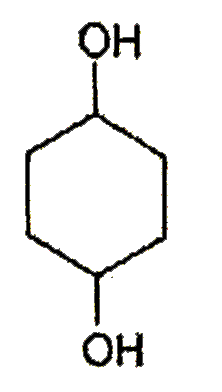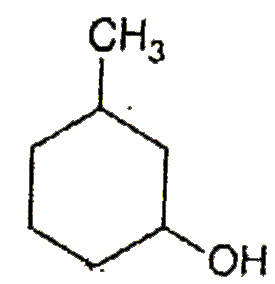Maximum dehydration takes place in that of




The correct Answer is:B
To determine which compound undergoes maximum dehydration, we need to analyze the options based on the presence of electron-withdrawing and electron-donating groups, as well as the stability of the resulting carbocation after dehydration.
1. Identify the Functional Groups:
- Each option contains a hydroxyl (OH) group, which is crucial for dehydration (removal of water).
- We need to consider the structure of each compound and the presence of any electron-withdrawing or electron-donating groups.
2. Analyze Electron-Withdrawing Groups:
- Electron-withdrawing groups (EWGs) increase the acidity of the hydrogen atoms attached to the carbon adjacent to the hydroxyl group. This makes it easier for these hydrogens to be removed as protons (H⁺) during dehydration.
- In the first and second options, the presence of carbonyl (C=O) groups acts as electron-withdrawing groups, enhancing dehydration.
3. Consider the Stability of Carbocation:
- After the removal of water (H₂O), a carbocation is formed. The stability of this carbocation is crucial for the dehydration process.
- The more stable the carbocation, the more likely dehydration will occur. Stability can be influenced by hyperconjugation and the presence of electron-donating or electron-withdrawing groups.
4. Evaluate Each Option:
- Option 1: Contains a carbonyl group, which is an EWG. However, the absence of acidic hydrogen adjacent to the hydroxyl group makes dehydration less favorable.
- Option 2: Also has a carbonyl group and is likely to form a stable carbocation due to hyperconjugation. This option shows the highest potential for dehydration.
- Option 3: Contains two hydroxyl groups, which do not enhance dehydration due to lack of electron-withdrawing effects.
- Option 4: Contains a methyl group (an electron-donating group), which decreases the acidity of the adjacent hydrogen, making dehydration less favorable.
5. Conclusion:
- Based on the analysis, Option 2 is the compound that undergoes maximum dehydration due to the presence of an electron-withdrawing group and the stability of the resulting carbocation.
Final Answer:
Maximum dehydration takes place in Option 2.
---
- Each option contains a hydroxyl (OH) group, which is crucial for dehydration (removal of water).
- We need to consider the structure of each compound and the presence of any electron-withdrawing or electron-donating groups.
- Electron-withdrawing groups (EWGs) increase the acidity of the hydrogen atoms attached to the carbon adjacent to the hydroxyl group. This makes it easier for these hydrogens to be removed as protons (H⁺) during dehydration.
- In the first and second options, the presence of carbonyl (C=O) groups acts as electron-withdrawing groups, enhancing dehydration.
- After the removal of water (H₂O), a carbocation is formed. The stability of this carbocation is crucial for the dehydration process.
- The more stable the carbocation, the more likely dehydration will occur. Stability can be influenced by hyperconjugation and the presence of electron-donating or electron-withdrawing groups.
- Option 1: Contains a carbonyl group, which is an EWG. However, the absence of acidic hydrogen adjacent to the hydroxyl group makes dehydration less favorable.
- Option 2: Also has a carbonyl group and is likely to form a stable carbocation due to hyperconjugation. This option shows the highest potential for dehydration.
- Option 3: Contains two hydroxyl groups, which do not enhance dehydration due to lack of electron-withdrawing effects.
- Option 4: Contains a methyl group (an electron-donating group), which decreases the acidity of the adjacent hydrogen, making dehydration less favorable.
- Based on the analysis, Option 2 is the compound that undergoes maximum dehydration due to the presence of an electron-withdrawing group and the stability of the resulting carbocation.
Maximum dehydration takes place in Option 2.
Topper's Solved these Questions
- BOOK - BITSAT GUIDECHAPTER - ALDEHYDE AND KETONESEXERCISE - Bitsat Archives14videos
ALDEHYDE AND KETONES
- BOOK - BITSAT GUIDECHAPTER - ALCOHOLS, PHENOLS AND ETHERSEXERCISE - BITSAT Archives14videos
ALCOHOLS, PHENOLS AND ETHERS
- BOOK - BITSAT GUIDECHAPTER - CARBOXYLIC ACID AND DERIVATIVESEXERCISE - All Questions34videos
CARBOXYLIC ACID AND DERIVATIVES
Similar Questions
Knowledge Check
- Question 1 - Select One
Maximum hydration takes place of :
ACF3O∣∣CCF3BCH3O∣∣CCH3CCH3CH∣Cl−O∣∣CCH3DC6H5O∣∣CC6H5 - Question 2 - Select One
Maximum digestion takes place in ?
ADuodenumBJejunumCIleumDColon - Question 3 - Select One
Maximum enolisation takes place in
ACH3COCH3BCH2COCH2CHOCCH3COCH2COCH3D


